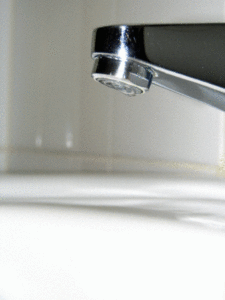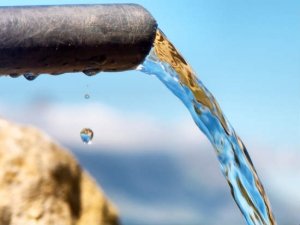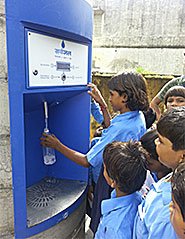Since I track news on water, it wasn’t too difficult to see when the sudden epidemic of news about these miraculous solar powered water ATMs hit. Last couple of days. The news before that is last year, then the year before last, and so on, right back up to the year 2008 – when Piramal started selling water (very cheap) to communities without access to clean, drinking water. Very philanthropic, one would imagine, except the miracle technology being described in the articles wasn’t being described at all. So what was being reported? Here are some examples:
and so on.
With minor variations, the story is the same. A miracle fix for our country’s water woes. Affordable drinking water. And so on. Sarvajal currently not making a profit is seen as a halo, but creating a market out of a fundamental need is hardly a loss making proposition, so I’ll save my tears of concern here.
Most of the articles are very upfront that this is not an NGO, but a for profit company Sarvajal backed by Piramal Enterprises. The era of purchasing drinking water and praising the lord that it is cheap, is here. Except, none of the articles have noticed it in the flood of clear, drinking water. Paid for by an ATM card, of course.

Considering that there is an abundance of people who think lie a certain ex-CEO of Nestle and see water as a commodity that must be paid for, rather than a basic human right, I’m not going to get into that ugly debate here. I’m going to raise several other questions about this miracle.
- This company digs bore wells (or makes its franchisees dig borewells) to access water to treat through reverse osmosis to sell. Underground water aquifiers are a national resource and the indiscriminate use of them, particularly in a way that spoils the quality of water is a crime against the country. Even if you pay people to use the water instead of selling it cheap.
- The Sarvajal plants are using the waste water from the reverse osmosis to recharge the ground water. I have no idea why they are doing this, but then I have no idea what else they could do with brine either. Offer it as a substitute in processes that need salt water? My guess is that “recharging the ground water” is just a pretty term for treating a borewell like your gutter, because the brine from the Reverse Osmosis contains the Totally Dissolved Solids from the water that got cleaned as well. In other words, if you are operating on a 50% efficiency (the plants are capable of 65% according to the blog of someone who worked there), then the waste water is TWICE as problematic as the water you began with. Dumping that into the water source makes zero sense.
- But it isn’t like these concerns haven’t been raised. A Business standard article from January says: D C Garg, hydrologist at the district groundwater department, says this process may increase the TDS content in groundwater. But Anuj Sharma, chief operating officer of Sarvajal, argues that only 0.5 per cent of the extracted water is used for drinking. Most is used for agriculture, shows groundwater extraction data. The rather casual answer is worrisome, because it ignores the fact that the Sarvajal plant will make the water worse for those who are not their clients and still use ground water for drinking. A sort of self-fulfilling business if the purification plant is making the water worse than it used to be, so that it can’t be used without their technology. This is rather alarming when you are speaking of the water of an entire area at large. The casual dismissal of concerns about water quality should raise alarms.
- But can the 99.5% of water used for agriculture purposes be dismissed so easily? An irrigation experiment with saline water at different concentrations was carried out over a 7-year period on the same clay–silty soil in the Volturno Valley at Vitulazio to evaluate long-term effects of irrigation with saline water on crops and soil. The abstract of the research paper ends with the following paragraph. Irrigation with saline water led to an increase in ESP and a degradation of the soil physical properties that were estimated indirectly by measuring aggregate stability in water (IASW). The index of aggregate stability in water for the top layer (0–0.15 m) was inversely correlated to the ESP values, even after the leaching due to the autumn–spring rainfall. Can a business be allowed to risk this for the entire region?
- While drinking water does not need approval from environment ministry, how can it be that adding undrinkable water to the water aquifer is not prohibited? The Environment Ministry needs to answer for why it allows clear degradation of the quality of the water across the country so that dependence on commercial methods increases.
 Finally, I think it is not about the cost of the water, but the responsibility of the water. Citizenship of the country cannot be divorced from the right to life essential resources in it. It is not a question of who provides the cheaper water, but a question of the responsibility for providing clean water being transferred to individuals without access to water bodies, so that they end up becoming purchasers of a fundamental need. It is a different matter if the Reverse Osmosis unit were owned by a village to provide water for people in it and the resulting degradation of the water table were accepted by the residents of the area jointly.
Finally, I think it is not about the cost of the water, but the responsibility of the water. Citizenship of the country cannot be divorced from the right to life essential resources in it. It is not a question of who provides the cheaper water, but a question of the responsibility for providing clean water being transferred to individuals without access to water bodies, so that they end up becoming purchasers of a fundamental need. It is a different matter if the Reverse Osmosis unit were owned by a village to provide water for people in it and the resulting degradation of the water table were accepted by the residents of the area jointly.
This is also a convenient excuse for the government to abdicate its responsibility to ensure sustainable water distribution across the country and hand over more and more of this precious resources into the control of corporations. The low price is the lure, but the destination is still the abdication of your  Also, it is not true that extracting ground water is the best choice for drinking water. Rainwater harvesting is a far superior method of collecting and storing drinking water that needs no processing to be drinkable. Rainwater harvesting is also an urgent need in a country that is expected to be mostly water scarce in another couple of decades. Depleting ground water is a dangerous way of getting water, as depleted tables will mean the need to sink borewells deeper and deeper. Ground water is also not infinite, and reckless extraction will result in wells running dry.
Also, it is not true that extracting ground water is the best choice for drinking water. Rainwater harvesting is a far superior method of collecting and storing drinking water that needs no processing to be drinkable. Rainwater harvesting is also an urgent need in a country that is expected to be mostly water scarce in another couple of decades. Depleting ground water is a dangerous way of getting water, as depleted tables will mean the need to sink borewells deeper and deeper. Ground water is also not infinite, and reckless extraction will result in wells running dry.
To base a method of substituting a government responsibility with a product that is created through a shared resource and that damages the shared resource in the long run cannot really be seen as a long term solution. Yet, more and more areas are buying bottled water for drinking. Sarvajal is planning an expansion, as are other “brands” of water, but there is little news on rainwater harvesting, sustainability, pollution control or equitable distribution of water that puts life over industry.
Faced with droughts every year, we continue with our reckless worship of development that boils down to commodification of public resources in an extremely short sighted manner. The government simply does not care to monitor hens that lay golden eggs – be it taxes, or providing the people an alternative to revolting against their theft of natural resources.









Use of RO plant in houses is lot of waste of water. It must be mandatory to use it by storing in the same house for other uses
I think the article suggests that solving one problem leads to creation of problems of far reaching impact on the water resource. This is not a holistic solution. We must look for a method which is sustainable. This technology driven method does not appear to be sustainable. Ministry of environment must look into this.